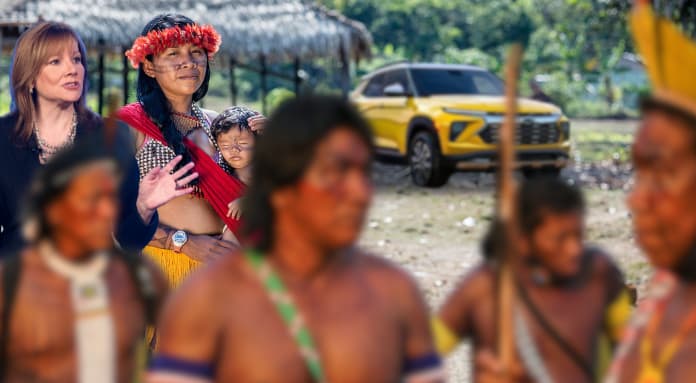It was several months ago when an expedition consisting of Ruggero Yates, Edward Monroe, and Faye Jonas left to explore the Amazon region. While the area has been visited and extensively studied by many in the last several years, this expedition was going to be a unique one, as it was going to be undertaken in a 2024 Chevy Trailblazer.
Many had assumed that this was nothing but a publicity stunt by GM, who are trying desperately to improve their image after CEO Mary Barra oversaw several child sacrifices to improve dwindling sales. However, the expedition’s leader, Ruggero Yates, insisted that this was for the betterment of humanity and a brave new step in the combined fields of sociology and anthropology.
The expedition maintained contact with the public for the first leg of their journey. The group reported several findings that were soon the talk of many. “While the pedestrian detection feature on the Chevy Trailblazer has no problem locating humans, it has difficulty seeing ocelots, as we’ve already run over several,” Yates reported. “The vehicle’s AWD was decent for off-roading, but operating on the jungle floor has been quite a difficulty. The navigation system is hard to operate due to the limited capability of the WiFi hotspot operating so far from the United States.”
Their last communication spoke of the optimism the explorers had regarding making contact with some of the local tribes, as Yates spoke openly about the contributions to anthropology this would make. “Imagine the possibilities. These indigenous tribes have never seen a white man, yet alone a subcompact crossover SUV. The marketing potential would be enormous. Once some of this pesky jungle is out of the way, new factories and dealerships could reach a whole new demographic. The automotive industry could expand operations, and we could document the cultural advancement of the tribes and learn about their customs.”
This was the last we heard of the expedition. Now, Henry Kerman, a professor of anthropology at Warren G. Harding University, has brought some new theories to the case that might predict a gruesome end for the explorers and their Trailblazer. “Disturbing an indigenous population can be very dangerous,” said Kerman. “These people have been isolated from the modern world and only know of their own customs and traditions.” Kerman then cited an expedition from several years ago where a group of students took an Isuzu Amigo and attempted to explore some islands off the coast of New Guinea. The native population, assuming that the SUV was an evil sea turtle, attacked the expedition with bows and arrows, then attempted to roast the vehicle in a ceremonial feast. The charred remains of the vehicle and its occupants were later found by missionaries, who were there to treat a widespread epidemic of dysentery following the consumption of the vehicle’s tires and powertrain.
We asked Kerman if the Yates expedition could have suffered a similar fate. The professor was anything but optimistic. “It’s hard to be certain. I know several tribes around the world are hostile to any outsiders, and a group of three strangers emerging from a subcompact SUV could very well be taken as a either a threat, or seen as demons being birthed from a vengeful god once they departed the vehicle.” When asked if he thought a search and rescue mission should be attempted, the professor was rather blunt about the prospects. “What do you think this is, Cannibal Holocaust? Those sorts of things only happen in the movies.”
We’ll do our best to keep you updated as this story develops.












